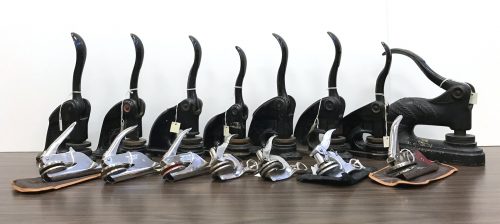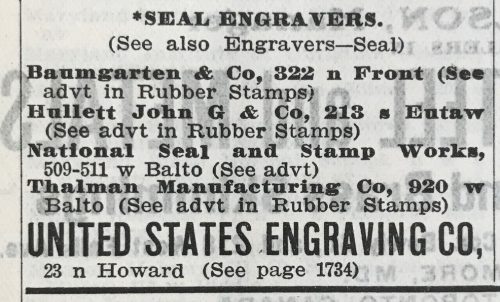An Efficiency of Seal Presses
A blog post by Collections Manager Joanna Church. To read more posts by Joanna click HERE.
There are arguments to be made in favor of collecting multiple iterations of an artifact. Our focus here is history, not decorative arts, thus manufacturing techniques, stylistic development, and change over time are not as much our concern as is the story each individual artifact can tell about its creation, owners, and uses. But the opportunity to compare similar items can be useful to a history museum, allowing us to look at them across a broader spectrum, and to combine those individual elements into a larger context. Think of wedding gowns, for example, or sports trophies: On their own they can help us share a single story; shown as a group, they can illustrate the varying choices made by brides from different cultures, classes, or religions, or the shift in a community from one favored athletic activity to another.
Those might be obvious choices for ‘they’re-the-same-but-different’ artifacts, but I’ll offer another: the humble embossing or seal press.

What do you call a group of vintage office supplies like this – a herd? A flock? A flotilla? Then it came to me: of course, this is an efficiency of seal presses.
We recently accepted a seal press from the Jewish Convalescent & Nursing Home of Baltimore. By itself, it can serve as a material introduction to this long-standing institution. But that will have to wait for another blog post! For our purposes today, it has joined its friends. We have fifteen embossing presses in the collection, covering many decades and representing an impressive variety of social, religious, and charitable organizations, as well as businesses.
-“Hebrew Education Society, Baltimore City, 1860 amended 1900.” Anonymous gift. JMM 1997.051.001
-“Jewish Convalescent & Nursing Home Society, Maryland, Incorporated Nov. 6, 1936.” Gift of Michael Moranz. JMM2018.018.001
-“Chevrah B’nai Abraham, Incorporated. Organized Jan. 25, 1916.” Gift of Lillian Sapperstein. JMM 1999.164.002
-“Tifereth Israel Congregation of Forest Park. Incorporated 1926. Maryland.” Gift of Howard L. Cohn. JMM 1999.014.007
-“Hebrew Orthodox Free Burial Society, Baltimore, Md.,” with the organization name in Hebrew in the center. Gift of Victor Resnick. JMM 2001.105.001
-“The Hebrew Ladies Free Loan and Charities of Baltimore, Md. Incorporated 1902.” Gift of Roslyn Tamres. JMM 2003.042.001
-“Twentieth Century Athletic and Literary Club, Organized Dec. 16, 1901. Incorporated Oct. 20, 1903.” Gift of Edwin B. Early. JMM 1991.161.001
-A long-reach press. “Grand Order Brith Shalom [sic] of Baltimore City, Incorporated Aug. 16, 1902.” Gift of Paul Miller for Brith Sholom. JMM 1995.209.021
Front row, hand-held or pocket presses, left to right:
-“Pickwick Cemeteries, Inc. Incorporated 1985.” Gift of Howard L. Cohn. JMM 1999.014.009
-“Ruth Kessler, Notary Public, Baltimore, Maryland.” Gift of the Kessler family. JMM 2005.055.002
-“Har Zion – Petach Tikvah – Tifereth Israel Cong. Maryland 1972.” Gift of Howard L. Cohn. JMM 1999.014.008
-“Petach Tikvah Congregation, Incorporated 1921.” Gift of Howard L. Cohn. JMM 1999.014.006
-“Rodfe Zadek [aka Rodfe Tzedek or Zedek] Congregation of Baltimore,” with the congregation name in Hebrew in the center. Gift of Ken Zajic for Rodfe Zedek Cemetery. JMM 1996.168.001
-“Anshe Beth Jacob Congregation, Maryland. Incorporated 1922.” Gift of Ruth Mandle. JMM 1982.014.003
-“Hebrew Friendship Cemetery Company of Baltimore City, Incorporated June 20, 1902.” Gift of The Associated. JMM 2015.003.001
So what is a seal press? Each of these, whether designed to sit on/attach to a table (the large, heavy, cast-iron presses in the back row) or to be held in the hand, contains a pair of metal die. Slip a piece of paper between the die, press down the handle, and you end up with an embossed imprint of your desired text or image.
The incorporation dates of the organization do not necessarily mean that’s when the press was purchased, though it does provide a handy terminus post quem, the earliest date it could have been produced (i.e., it wasn’t made before the organization was incorporated). It is also possible to change out the seal imprint, meaning an older press might hold a newer seal. However, other info can help us narrow down the dates during which a particular press was made, purchased, and used. Several of the hand presses have patent dates, ranging from 1895 (the Rodfe Zadek Congregation press) to 1961 (Pickwick Cemeteries). None of the table-top presses have patent dates or maker’s marks, unfortunately, and like their smaller friends, this basic design was used from the 19th century well into the 20th. This example, from suburban DC, looks old-school but its seal dates it fairly specifically to the 1960s; similar tools were used as early as the 1780s. In the case of these presses, the dates of the organization are our best bet for determining dates of use.
At least one Baltimore firm is known to have made the cast-iron presses; here’s an example by the Pearce F. Crowl Company of Baltimore, at the Museum of Vancouver.

This may be the same company (under a mis-read name or taken over by a relative?) as the Pearre E. Crowl Company, Engravers, Printers, Stationers and Rubber Stamps, found in the 1905 Baltimore directory.
So what do these artifacts, as a group, tell us? Several of the hand presses are the same brand, “Official Pocket Seal,” with successive patent numbers proudly stamped on the handles: the earliest example boasting the 1937 patent, with later presses adding patents from 1939, then 1953, then 1961. That’s a nice little material culture comparison exercise right there. Of more specific use to us, three of the seals – one table-top, two hand – trace the merger of congregations: separate seals for Petach Tikvah (founded 1921) and Tifereth Israel Congregation of Forest Park (founded 1926), and a later seal for the now-combined Har Zion – Petach Tikvah -Tifereth Israel Congregation (founded 1972).
Even though the rest are not directly related to each other, altogether they provide an overview of the types of organizations and businesses that were important to Baltimore’s Jewish community: a sampling of the broader JMM collections, in one tidy batch.



